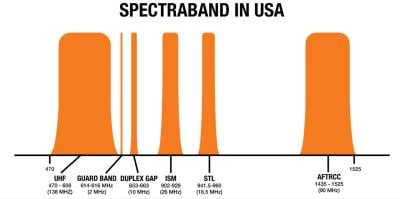Sound Devices, traditionally known for recording technologies, is moving into the live entertainment market with SpectraBand, released this summer with the goal of helping sound engineers and designers on the road with finding clean, usable, RF frequencies.
Matt Anderson talked to Live Design about this, and other, Sound Devices products.
Live Design: How long has Sound Devices been around?
Matt Anderson: Sound Devices was founded in 1998, and for the past few decades we’ve been designing and manufacturing professional audio equipment that embodies our passion for dynamic, pristine sound quality in increasingly smaller and more robust packages.
We’re perhaps best known for our portable mixer-recorders that have been embraced by the film and television production industry, but our products see use with audio professionals around the world in a variety of use-cases.
We released our first serious wireless product, the A10 Digital Wireless System, in 2018 and have been exploring the technology in-depth ever since. Our offices are in Reedsburg, Wisconsin, Madison, Wisconsin, and Watford, UK.
LD: What is the problem that you new product, SpectraBand, sets out to address?
MA: SpectraBand came about because of some trends that we’d noticed over the past fifteen years. As the use of wireless microphones has proliferated in all areas of the professional audio industry, the need for clean, usable, RF frequencies has never been higher. At the same time there are less legal UHF frequencies available as these frequencies have been auctioned off for use by telecom companies and ISPs. Not only that, but the expanded use of wireless technology in general means that the remaining frequencies are often riddled with interfering signals.
This problem is especially prevalent for live event production when you consider the RF interference that can be generated by video walls, expansive lighting rigs, and other live stage technology. Also, if you are in a touring show, the available legal frequencies can differ by territory which often requires a different set of receivers and transmitters depending on where in the world you are. It’s a very hostile environment to run wireless audio in, and seeing all of this we thought there was an opportunity to address all of these problems with a single device.
LD: Were you running into this issue with your previously successful products? If so, is this because the RF environment is getting busier or because of the way your products were being used in a changing market? Or both?
MA: When we launched the A10 range it worked great, but having so many SKUs to accommodate the RF needs for the different regions seemed counterproductive to our goals. One of our guiding principles as engineers and designers has been streamlining the experience of using our products. We’re always aware of the plight of the on-the-go sound mixer and as such we’re motivated to make that person’s job easier. Designing a solution that would minimize the amount of extra equipment for that person to be responsible for increasingly made sense. We saw an opportunity to consolidate everything that we’d learned about wireless and to push the envelope on the technology. This is what led us to SpectraBand and our first SpectraBand-equipped device, the A20-RX.
It’s also worth noting that at Sound Devices, we don’t rest on the laurels of our past triumphs. We stand by every product we’ve ever designed, but as consummate engineers we’re always looking for ways to make these devices work smarter, better, faster, at higher quality, and in a smaller chassis. It’s what makes the work rewarding for us.
LD: What makes SpectraBand differ from competitor products?
MA: From the onset, SpectraBand offers an unprecedented tuning range compared to competitor products – 470 MHz to 1525 Mhz. We’re currently the only company offering transmitters and receivers that can do this, and this encapsulates the maximum amount of free frequencies no matter where you are in the world. ‘More free frequencies’ is also an ease of use concept in the meta sense as well, because it doesn’t require you to carry additional gear to accommodate where you are geographically. This makes it fairly unique for a live touring setup because you can travel the world with one consistent wireless system, and also means that rental companies don’t need to stock as many variations of the same wireless product.
I would also say our products are easier to use from a setup and operation standpoint. They are very resistant to frequencies outside of a given band because we use SAW (Surface Acoustic Wave) filtering, which is a real ‘brick wall’ to keep out the myriad of interfering frequencies and RF congestion that can occur in a live event setting. Simply put, the range of SpectraBand lets you find the clean frequencies easily, the filtering ensures stability of transmission and reception, and our component choice and precision engineering means it all fits in a device that is small, robust, and easy to operate.
LD: Does the release of this product mean Sound Devices is going to expand further into the live entertainment industry versus recorded entertainment?
MA: We’re always examining new markets and looking to see where we can take what we’ve learned and apply it to different use cases and professional applications. SpectraBand technology has a lot of obvious advantages for the live entertainment industry, and we’re investigating ways to implement those in future product design.
LD: What else do you have in the works?
MA: It’s become common knowledge about our company that while we talk to our customers daily, we rarely talk about new products until launch day is upon us. The reason behind this is that we like to focus completely on synthesizing products out of what customers have requested, along with ideas we've thrown into the mix, and get the product right. It takes an incredible amount of time and energy to get all the details of a product nailed.
That being said, we have some exciting announcements planned in the coming months, so as ever, stay tuned…
